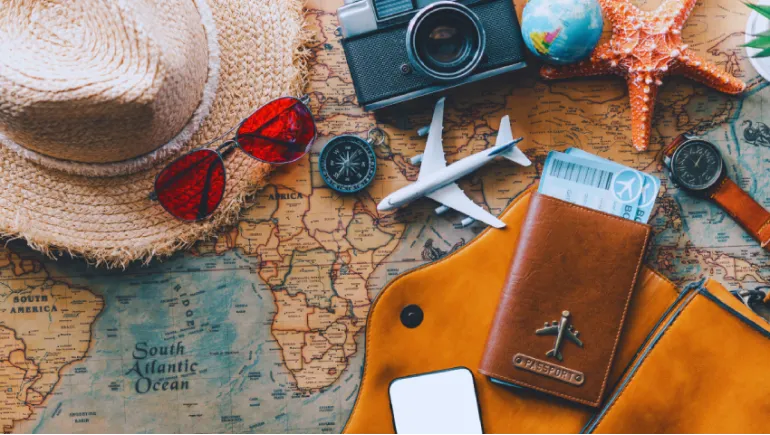
As a seasoned travel writer with over a decade of exploring 40+ countries, I’ve navigated everything from bustling megacities to remote wilderness. In 2025, travel is evolving rapidly, driven by technology, sustainability, and shifting global trends. Drawing on my experiences and the latest industry insights, this guide offers practical, expert-backed tips to make your trips seamless, eco-conscious, and unforgettable. Whether you’re a solo backpacker or planning a family getaway, these strategies will help you travel smarter in 2025.
Technology is reshaping travel planning, making it more intuitive and personalized. AI-powered platforms like Google Travel and TripIt now integrate real-time data for flights, accommodations, and itineraries, optimizing for cost and preferences. In my recent trip to Japan, I used AI tools to score a $200 flight deal by adjusting dates dynamically. Apps like Rome2Rio offer multi-modal transport options, blending trains, buses, and rideshares for seamless connections.
For 2025, leverage AI chatbots for real-time updates on delays or local events—Skyscanner’s AI assistant, for instance, suggests hidden gem destinations based on your budget. However, cross-check AI suggestions with trusted platforms like Lonely Planet to avoid outdated info. Always back up digital itineraries with offline copies, as connectivity can falter in remote areas.
Sustainability is a top trend for 2025, with 78% of travelers prioritizing eco-friendly options, per Booking.com’s 2025 Travel Predictions. Choose accommodations certified by Green Globe or LEED, which focus on energy efficiency and local sourcing. In Costa Rica, I stayed at a carbon-neutral ecolodge, reducing my footprint while supporting local communities.
Opt for low-carbon transport like trains—Europe’s rail network, expanded in 2025, offers high-speed routes like Paris to Berlin in under seven hours. If flying, use tools like Google Flights’ carbon emissions tracker to select greener routes. Pack reusable items—water bottles, utensils, and cloth bags—to minimize waste. My go-to is a collapsible silicone bottle, which saved me $50 on bottled water during a month-long Southeast Asia trip.
Overtourism is pushing travelers toward lesser-known spots. Forbes highlights places like Slovenia and Bhutan as 2025’s must-visit destinations for their pristine nature and cultural authenticity. I explored Lake Bled in Slovenia last year—its emerald waters rival Lake Tahoe but with fewer crowds.
Research local customs to respect cultural norms; for instance, Bhutan requires guided tours to preserve its heritage. Platforms like Culture Trip provide insights into offbeat destinations, while social media posts from local influencers offer real-time vibes. Book early for these spots, as social media buzz can spike demand quickly.
Packing efficiently is crucial, especially with stricter airline baggage rules in 2025. Invest in modular gear like the Osprey Farpoint 40, a carry-on backpack with detachable daypacks, perfect for mixed itineraries. I’ve used it across urban and hiking trips, fitting everything into 40 liters.
Use packing cubes to organize outfits and tech—my Anker charging hub keeps devices powered without bulk. For tech, a universal adapter with USB-C ports is non-negotiable; I recommend the Tessan model for its compact design. Pack versatile clothing: merino wool layers work for both chilly Alps mornings and warm Mediterranean afternoons. Always include a lightweight rain shell—weather apps like AccuWeather are reliable but not foolproof.
Safety remains paramount, especially in unfamiliar regions. The U.S. State Department’s Smart Traveler Enrollment Program (STEP) provides real-time alerts for your destination. Apps like GeoSure assess neighborhood safety using crowdsourced data, which I found invaluable in Bogotá’s varied districts.
Cybersecurity is critical—use a VPN like NordVPN for public Wi-Fi to protect sensitive data. In 2025, digital IDs are gaining traction; Apple Wallet now supports passports in select regions, streamlining airport processes. Still, carry physical copies of your passport and visas, as tech adoption varies. Blend in by dressing like locals and avoiding flashy items—my minimalist wallet deterred pickpockets in crowded markets.
Travel costs are rising, but savvy strategies keep expenses down. Skyscanner and Kayak report flexible dates can save up to 30% on flights. I saved $150 on a London flight by shifting my trip by two days. Use price alerts on Hopper to snag deals—ideal for spontaneous travelers.
Loyalty programs are evolving; Marriott Bonvoy and Delta SkyMiles offer cross-partner redemptions, like hotel points for flights. For budget stays, Hostelworld’s verified hostels provide safe, social vibes under $30/night in cities like Lisbon. Always compare platforms—Booking.com often undercuts Airbnb for similar listings.
Authentic experiences define memorable trips. Culinary tourism is booming, with 64% of travelers seeking local food, per American Express. In Vietnam, I joined a street food tour via GetYourGuide, tasting phở from vendors locals love. Platforms like WithLocals connect you with residents for private tours, from pottery workshops in Morocco to fjord hikes in Norway.
Voluntourism is also trending—projects like coral restoration in Bali blend travel with impact. Ensure ethical operators by checking certifications like Fair Trade Tourism. Avoid tourist traps by using Tripadvisor’s “Things to Do” for vetted activities.
Wellness travel is a 2025 priority, with spas and retreats integrated into itineraries. Wearables like the Fitbit Charge 6 track jet lag and activity, helping you stay balanced. I used mine in New Zealand to monitor sleep after long flights, adjusting my schedule for energy.
Carry a compact first-aid kit and research healthcare access—apps like Air Doctor connect you to local clinics. Stay hydrated and prioritize local, nutrient-rich foods to maintain stamina. Yoga apps like Down Dog offer quick sessions for hotel rooms.
Travel in 2025 is about blending tech, sustainability, and authenticity. From AI planning to eco-conscious choices and immersive local experiences, these tips—rooted in my global journeys and industry trends—ensure your adventures are seamless and impactful. Start planning now, embrace flexibility, and let 2025 be your year of unforgettable travel.












Comments
There are no comments for this Article.